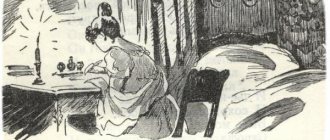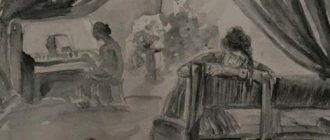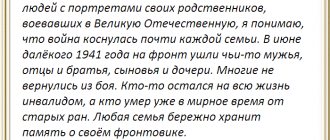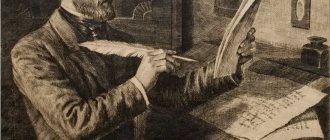Time of writing
The plot of the work takes place in the period from 1819 to 1825. The era of the creation of “Eugene Onegin” is fully reflected in the work and covers not only historical events, but psychological portraits of the heroes of that time. The author himself notes that creating the work was not easy for him. He writes that “Eugene Onegin” is “the fruit of a mind of cold observations,” but at the same time, “sorrowful notes of the heart” reflect Pushkin’s deep immersion in the study and analysis of the morals of the nobility, his emotional experiences.
The year the work was written is not a clear date. Work on “Eugene Onegin” begins in the spring of 1823. At this time, Alexander Sergeevich is in the city of Chisinau, in exile. The author finished writing the novel after the first chapters were published in a magazine that was fashionable at that time. Work on the work was completed in 1830 in Boldin.
The novel reflects the first half of the 19th century. After the defeat of Napoleonic army, during the campaigns of Russian soldiers, society in Russia actively developed under the leadership of ruler Alexander I. It was at this time that the plot of the novel unfolds.
The history of the creation of Pushkin’s novel “Eugene Onegin”
Alexander Sergeevich Pushkin created his immortal novel in verse “Eugene Onegin” for a long time.
He began working on the novel on May 9, 1823, while in southern exile in Chisinau. And he finished it during the Boldino autumn, in 1830.
More than seven years have passed. During this time, important events took place in the poet’s life that brought great changes.
Pushkin spent many years in exile: in the south and in the Mikhailovskoye village. Traveled around the Caucasus. He experienced separation from close friends after the Decembrist uprising.
He wooed Natalya Goncharova, and about six months before the upcoming wedding celebration, Pushkin put the finishing touches on the novel.
The first complete edition of the imperishable novel was published almost 3 years later - in 1833. It created a sensation among the reading public and instantly flew off the shelves.
By that time, Alexander Sergeevich was already Goncharova’s legal husband and the father of two children, a daughter and a son.
The author nurtured the idea of the novel for a very long time.
Sitting down to write the first chapter, the poet did not yet imagine the whole story. It was built only as the work was being written, and this is another distinctive feature of “Eugene Onegin”: the novel did not appear immediately, but, like a child, developed together with its “parent”.
And so it happened
...a collection of motley chapters, Half-funny, half-sad, Common people, ideal, The careless fruit of my amusements, Insomnia, light inspirations, Immature and withered years, The mind of cold observations And the heart of sorrowful notes.
The work was published in chapters, which were written by Pushkin as freely and freely as possible.
Then they intertwined with each other, and gradually a complete picture appeared before the readers, describing a simple story that could happen to anyone.
The author deliberately abandoned romantic traditions, bringing real life to the fore. This is how the first psychological novel in Russia, written in verse, appeared. A truly iconic work for all Russian literature!
After it there was no way to go back. “Eugene Onegin” turned all ideas upside down and opened the way for a new direction that would pass not only through the 19th, but also through the 20th century - realism.
The first chapter was published in 1823. The last, eighth, in 1831. The completely finished creation was published in 1833, and was republished in 1837, literally before the death of the author.
Initially, Pushkin planned nine chapters, but the last one contained too free thoughts and “wrong” sentiments, therefore, fearing another exile, the poet destroyed it.
The reader can imagine the future fate of the main characters, and this again demonstrates the maximum proximity of the literary text to life.
Indeed, in reality, we often lose sight of our best acquaintances, close friends with whom we spent some time in close contact.
Years pass, people part, knowing absolutely nothing about how the future fate of once dear comrades developed. So Onegin went on his way, leaving a noticeable, indelible mark on his soul.
Novel structure
"Eugene Onegin" marked the author's transition from writing in the style of romanticism to the style of realism. The novel includes 8 separate chapters. Each of them is a fully completed passage. The novel has an “open structure.” Each of the chapters could be the ending, but the story continues in a new chapter. With the help of this technique, Pushkin tried to draw attention to the fact that each of the chapters is independent and integral. The author himself defines the novel as “a collection of motley chapters.”
Initially, the work was planned to have 9 chapters. The part about the main character's journey was supposed to be the eighth. It was written, but at the last moment Pushkin decided to delete it from the book.
New in blogs
The novel “Eugene Onegin” occupies a central place in Pushkin’s work. This is the largest work of art, the richest in content, the most popular, which had the strongest influence on the fate of all Russian literature. Pushkin worked on his novel for more than eight years - from the spring of 1823 to the autumn of 1831. The surviving manuscripts of “Eugene Onegin” show what enormous work Pushkin put into his creation, how persistently and carefully, replacing one word with another, one phrase with another many times, he achieved the most accurate and poetic expression of his thoughts and feelings, how he changed He is in the process of working on both the plan for his novel and its individual details.
whole days without leaving his house, whole nights until dawn in this difficult and joyful work. At the very beginning of his work on “Eugene Onegin,” Pushkin wrote to the poet P. A. Vyazemsky: “I am now writing not a novel, but a novel in verse—a devilish difference.” In fact, the poetic form gives Eugene Onegin features that sharply distinguish it from a prose novel. In poetry, the poet does not just tell or describe, he somehow especially excites us with the very form of his speech: rhythm, sounds. The poetic form conveys the poet’s feelings and excitement much more strongly than the prosaic form. Each poetic turn, each metaphor acquires a special brightness and persuasiveness in poetry. In famous lines:
- Driven by external rays,
- There is already snow from the surrounding mountains
- Escaped through muddy streams
- To the flooded meadows...
we directly feel the victorious power of spring, which drives winter snows from the mountains, and the snows run away from it, turning into muddy streams...
All the action of the novel , all the descriptions, all the speeches of the characters, despite their simplicity, the complete absence of deliberate effects, are nevertheless, thanks to the poetic form, covered with special poetry and musicality. “Eugene Onegin” is also given a unique character by the constant participation of the poet himself in the novel. Onegin meets with Pushkin in St. Petersburg and Odessa, Tatiana’s letter is kept by Pushkin (“I cherish it sacredly”), he tells us, interrupting the course of events of the novel, episodes of his biography, shares his thoughts, feelings, dreams. In the form of lyrical digressions, Pushkin included many beautiful lyric poems in his novel, a poetic expression of his soul -
- Crazy cold observations
- And hearts of sorrowful notes.
Pushkin created a special form of the lyrical novel. The poems in “Eugene Onegin” do not flow in a continuous stream, as in almost all Pushkin’s poems, but are divided into small groups of lines - stanzas, fourteen verses (lines) each, with a certain, constantly repeating arrangement of rhymes. Pushkin uses this complex, difficult form, in which the flow of presentation would have to be constantly interrupted, with the greatest skill. She helps him move easily from one topic to another, from a story to a lyrical outpouring or reflection, and when he needs to carry on a continuous story, he does it so masterfully that we do not even notice the transition from one stanza to another.
The plot of "Eugene Onegin" is very simple and well known. Tatyana immediately fell in love with Onegin, and he managed to love her only after the deep shocks that took place in his chilled soul. But, despite the fact that now they love each other, they cannot become happy, they cannot unite their destiny. And it is not some external circumstances that are to blame for this, but their own mistakes, their inability to find the right path in life. Pushkin forces his reader to reflect on the deep reasons for these mistakes. This simple plot is presented by Pushkin according to a very clear, strict compositional scheme. Tatyana's love letter and Onegin's cruel rebuke in the first part of the novel reveal Tatyana's drama. Onegin's letter and Tatiana's response monologue in the second part depict the collapse of Onegin's love hopes. Between these main plot episodes are a series of events that were supposed to separate Onegin and Tatyana forever: the murder of Lensky in a duel and Tatyana’s marriage.
In “Eugene Onegin” many paintings and descriptions are strung on this simple And all this “collection of motley chapters, half funny, half sad, common people, ideal” is filled with the author’s lyrical outpourings, most of them very sad...
During the eight years of work on the novel, Pushkin changed both its content and composition several times. A few words must be said about these changes. “Eugene Onegin” was begun by Pushkin during a turning point in his work, when he was already disillusioned with romanticism, in its “sublime” heroes and plots, but had not yet arrived at a new, realistic task - the knowledge of life itself, its reflection in essential, typical features.
During this turning point (1823-1824), Pushkin wrote many gloomy, angry, irritated poems, such as “The Sower”, “Demon”, “Conversation of a Bookseller with a Poet” and others. He decisively moved away from his former romantic heroes and heroines, so beloved by himself and his readers, in which his own lofty feelings and thoughts were so poetically and sincerely expressed. But he felt this departure, this disappointment in romanticism very painfully, since he had not yet reached the point of seeing the poetic charm in the description, the depiction of simple life, simple, ordinary people - he, out of an old romantic habit, treated this simple life mockingly , ironically. So he began his novel in 1823, where he wanted to polemically, in a dispute with the then prevailing sublime romanticism, to show ordinary people, ordinary life in all its prosaic nakedness, without any idealization, without any romantic embellishment.
He made the hero of the novel not some mysterious “captive”, or Khan Giray, or the exile Aleko, but a young St. Petersburg dandy, and the heroine was a provincial young lady, not very beautiful, with a rustic, unpoetic name. The whole tone of the story was mocking at first. “In my spare time I am writing a new poem, “Eugene Onegin,” in which I am choking on bile,” Pushkin told friends in 1823. In a letter to his brother in 1824, he calls the novel he began his best work. “Don’t trust N. Raevsky, who scolds him,” writes Pushkin, “he expected romanticism from me, found satire and cynicism and did not lose heart.” Publishing the first chapter of “Eugene Onegin” as a separate book in 1825, Pushkin in the preface calls himself, as the author of this work, a “satirical writer.” This “satire” was directed against the romantic theory of the “sublime object”, the “sublime hero”.
But as time passed , Pushkin realized the extraordinary importance of a true, accurate, unvarnished image of the simple, everyday life that surrounds us, the importance of knowing through art what reality is like. Pushkin’s friend Nikolai Raevsky came to Odessa at the end of 1823, and Pushkin read to him the first chapters of “Eugene Onegin” exist, and he continued to write his novel calmly, without “bile”, without polemics, without deliberate, “satirical”, “cynical” protrusion of the most prosaic details of life.
The novel "Eugene Onegin" became the first truly realistic Russian novel.






